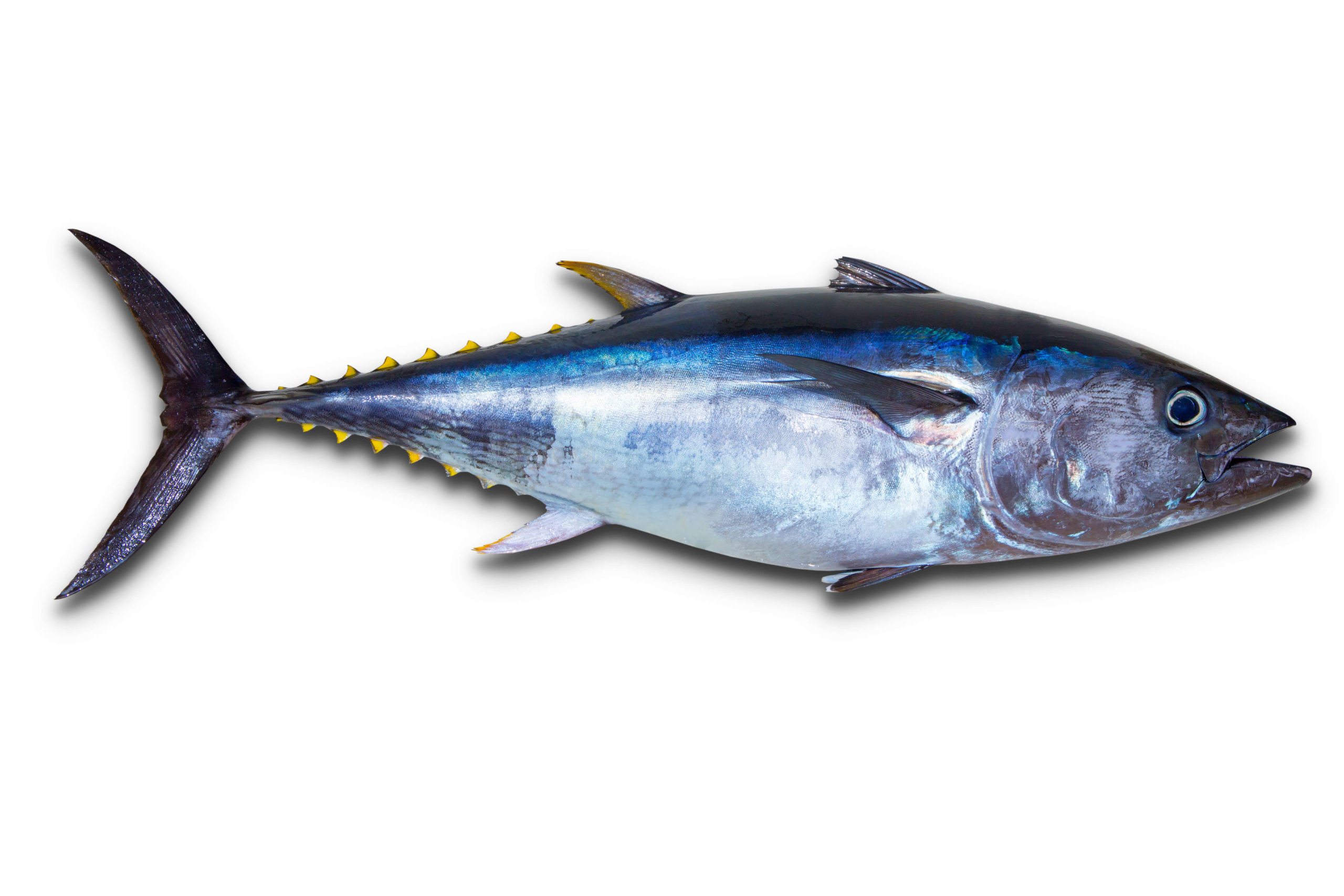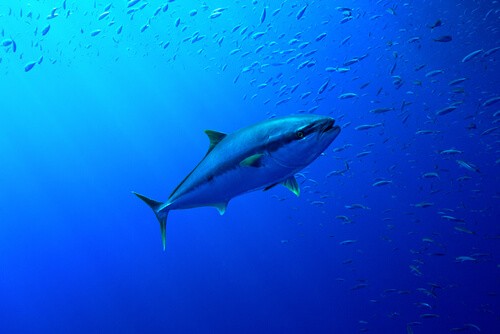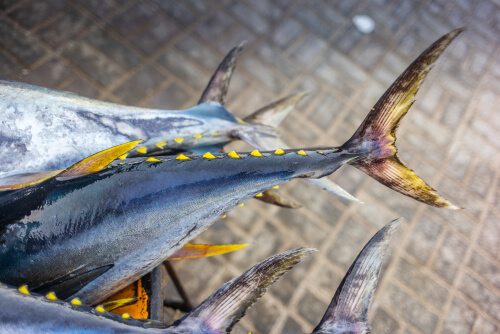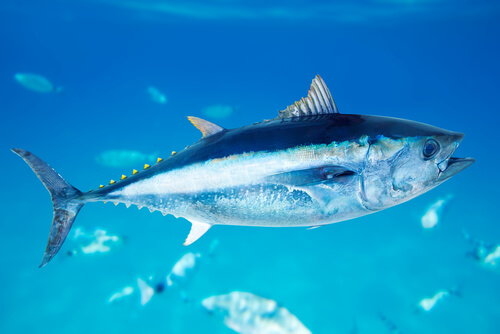
| Kingdom | Animalia |
| Phylum | Chordata |
| Class | Actinopterygii |
| Order | Scombriformes |
| Family | Scombridae |
| Genus | Thunnus |
| Species | T. albacares |
| Niche | Epipelagic predator |
| Length | 94 in (2.4 m) |
| Weight | 400 lb (180 kg) |
| Lifespan | 6-7 years |
| Social Structure | Schooling |
| Conservation Status | Near Threatened |
| Preferred Habitat | Surface waters |
| Average Clutch Size | Millions of eggs |
| Main Food Items and Prey | Fish, crustaceans, squids, etc. |
| Predators | False killer whale, mako shark, great white shark |
The Basics
The yellowfin tuna is a large predatory fish found in tropical and subtropical waters around the world. Known as ahi in Hawaii, it is one of the largest species of tuna and is a common target of commercial and sport fisheries throughout its range.
Description
The yellowfin tuna (Thunnus albacares), weighs over 400 pounds and can grow to 94 inches in length. This makes it larger than other tuna species such as the albacore tuna (Thunnus alalunga) but significantly smaller than the Atlantic and Pacific bluefin tuna. They have bright yellow dorsal and anal fins after which they are named. In some mature individuals, these fins can be very long, curving in a sickle-like shape towards their posterior. They also have long pectoral fins and yellow finlets along their tail with the main section of their bodies colored a dark, metallic blue or silver.

Habitat and Distribution
The yellowfin tuna is epipelagic, inhabiting mostly offshore waters relatively near the surface. They will occasionally be observed in nearshore waters under certain conditions. Many mid-ocean islands and underwater seamounts in the Pacific, Caribbean, and the Maldives are known as yellowfin feeding grounds for their high productivity that attracts many baitfish and other suitable prey items for the yellowfin. They normally travel in schools with other fish of a similar size including other tuna similar fish species. Sometimes these schools may associate with drifting items including vessels and other debris and waste.
Diet and Predators
Yellowfin tuna feed on a variety of species, using their muscular bodies to quickly dart at prey such as schooling baitfish. This may include some very fast species like flying fish and mackerel. They will also feed on pelagic crustaceans and squid, typically encountering the latter at night as they emerge from the depths to feed in surface waters under the cover of nightfall.
For their own part, young yellowfin are subject to this same predation they impose upon others when mature. This may include the threat of other larger tuna as well as seabirds, sharks, and other predatory fish. Toothed whales such as the false killer whale, marlins, and large shark species are some of the only animals known to prey on adult yellowfins. However, most mortality occurs as a result of industrial fisheries for tuna and other trophically important species.

Reproduction
Like most other tuna and many other fish species, yellowfin tuna are broadcast spawners. Females will release millions of eggs into the water column multiple times per year. Normally in response, males will release their sperm, with external fertilization occurring. This embryo floats in the water column as a member of the zooplankton community while developing into a larval fish and, eventually, a juvenile tuna capable of hunting for its own prey. The yellowfin tuna is a fast-growing species and has a relatively short lifespan of about 6-7 years. They become sexually mature at 2-3 years of age.
Due to intensive modern industrial fishing practices, many large species such as tuna are the victim of large-scale harvesting that can impact their populations significantly. Currently, the yellowfin tuna is listed as Near Threatened on the IUCN Red List of Threatened Species.
Fun Facts about the Yellowfin Tuna!
The yellowfin tuna is among the fastest fish species in the world and a voracious and efficient predator, leaving no shortage of fun facts and interesting insights to explore.
Warm-Blooded
Unlike most fish species, tuna are ‘warm-blooded’. This allows them to engage their large, strong muscles quickly, making it possible for them to escape predators or attack prey. This has also been believed to allow warm-blooded species to inhabit colder waters that wouldn’t otherwise be possible. This would provide them an evolutionary feeding advantage by allowing them access to the productive feeding grounds present in many temperate waters around the world. However, according to recent research, as oceans warm as a result of global climate change, this may be less and less of an evolutionary advantage for endothermic fish species such as tuna.
Beneath the Surface
Unlike some other tuna species which will regularly inhabit waters below the thermocline, the yellowfin tuna is known for its strong preference for surface waters, normally within 330 feet from the surface. Despite this, they do retain the ability to dive to impressive depths of over 3,000 feet, demonstrating that their preference for surface waters may be a response to ecological factors such as nutrient cycles, temperatures, and the increased productivity of surface waters rather than to physiological limitations that would restrict their ability to dive deeper like other tuna species.

Great Travellers
Yellowfin tuna, much like other tuna species, are excellent swimmers capable of reaching great speeds and traveling large distances. Their fins help to reduce drag in the water, highlighting how their form is well adapted to help them achieve these speeds and distances. Yellowfin tuna travel across entire oceans throughout their lifetime. In addition to being of interest to biologists and oceanographers, this also has significant implications in terms of conservation. Because the same fish stock can be observed in dozens of countries across large areas throughout multiple oceans, conservation and management of the fishery require international management and cooperation, something that is not always simple to achieve.
